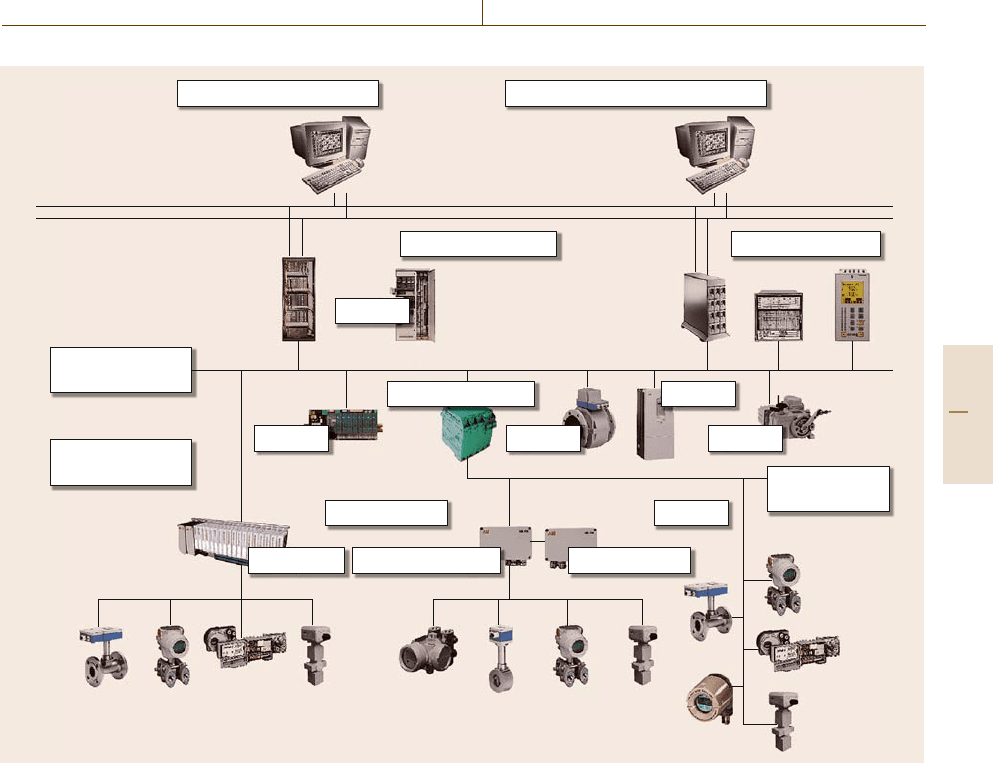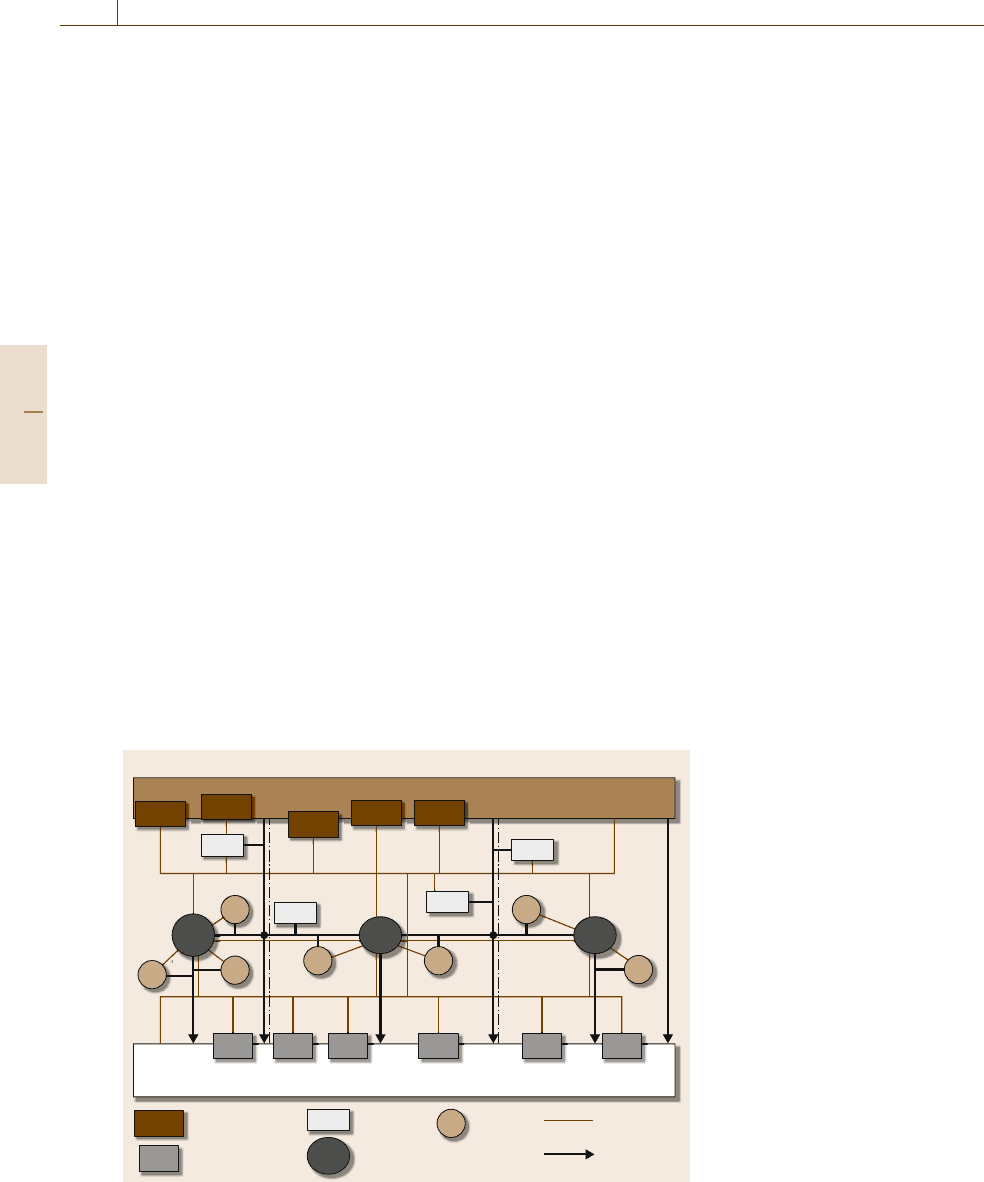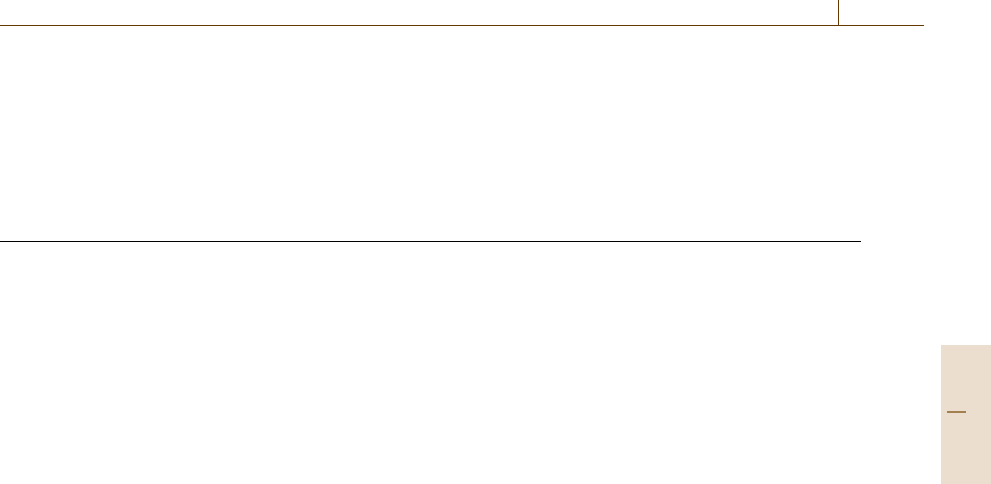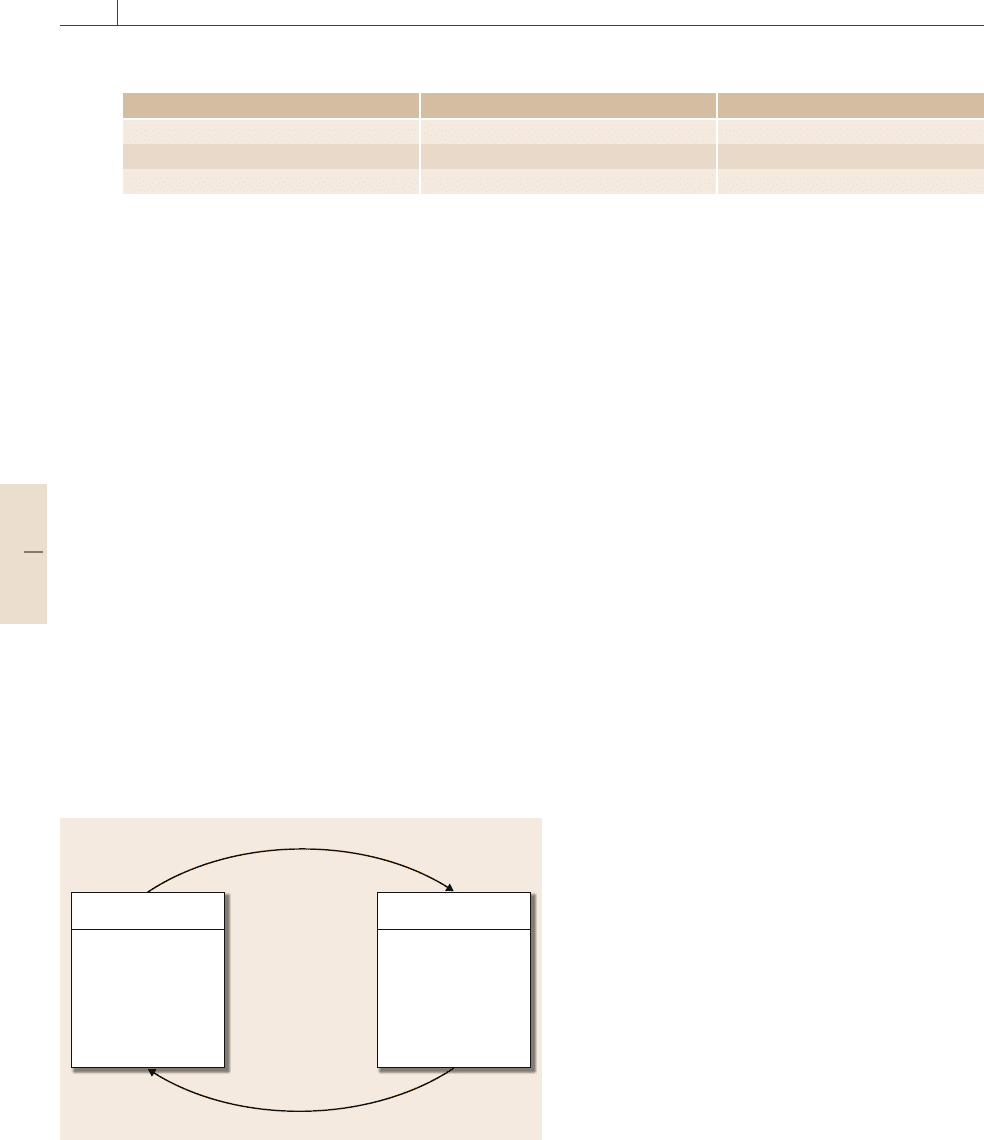Nof S.Y. Springer Handbook of Automation
Подождите немного. Документ загружается.


Service Automation 33.6 Information Required for Effective and Efficient Service 565
General purpose workstations
Control software for: Recording & control
DrivesLink device-coupler
MB204 cascadeMulti barrier MB204I/O S900-ex
ActuatorFlowI/O
MCC
Safe area
Industry standard
fieldbus H1
Industry standard
high speed fieldbus
Intelligent field
devices H1
Linking devices–gateways
High speed fieldbus devices
Hazardous area
PCs/workstations
Windows/UNIX
Process control
SCADA
Discrete robotics
Transmission network protection
Safety
Enterprise management software for:
Human systems interface
Engineering tools
Historical data collection
Asset optimization
Batch control
Fig. 33.9 Architecture of a plant with control and information flow down to the field device level [33.13](MCC: motor control
center; I/O: input/output; SCADA: supervisory control and data acquisition)
•
Failure reports
•
Proposed service actions
•
Detailed advice of how to carry out these actions,
including required tools
•
Information about spare parts, and their availability
and location
•
Information about urgency and time constraints
•
Data for administrative procedures.
Most of this information can be supplied automatically
to service personnel if it is available in a form that
allows digital data transfer.
This availability is the major bottleneck for the au-
tomation of service. Drawings of equipment may be
difficult to come by and/or the original supplier of this
equipment may no longer be available.
Drawings, for example, may be available but not
scanned, so that only physical copies can be used by
service personnel.
Gradually, suppliers of industrial equipment are
transferring their data to platforms allowing various
forms of access, a trend already established for many
consumer goods such as cars or washing machines, for
example.
Figure 33.7 shows the example of a data set used in
the service of transmission systems, where a failure in
the grid has to be located and identified, and the service
crew has to be sent to the correct location for repair.
In this multilayer view, geographical data, taken from
global position system (GPS) systems are combined
with detailed technical information, failure reports, and
historical aspects of the devices to be serviced.
Part D 33.6

566 Part D Automation Design: Theory and Methods for Integration
The way in which these different data are stored and
prepared for fast and easy retrieval is important for an
efficient service. Figure 33.8 shows a multidimensional
structure, in which, for each physical object of an instal-
lation – in this example a flow meter – a large number of
views are available: so called aspects of the equipment.
These aspects cover the items in the long list above.
The service engineer can either look at the aspects
of interest by opening the corresponding view or can be
supported by automated systems that collect and pre-
pare the relevant data for the task.
Obviously, for full use to be made of the data, it is
necessary that the data are available in the first place.
Service automation yields the highest benefit when the
automation architecture in the plant is adequate and
communication capabilities and products for all asset-
related information are possible.
Figure 33.9 shows an example of such an archi-
tecture that provides this information from the field
instrument level to the highest control level of a plant.
The data are recorded and analyzed in several dis-
tributed data management systems.
33.7 Logistics Support
Logistics is a support function whose objective is
guaranteeing the availability of required hardware
when service is performed. Such hardware is primar-
ily spare parts, but also includes maintenance parts
and tools [33.14–17]. The logistics function includes
inventory management and warehousing (stocking),
transportation planning and execution, including both
transportation to the customer site (or site where service
is performed), and the return of material (reverse logis-
tics). The challenge of this function is to optimize the
use of inventory and associated investment, while pro-
viding the service level required by service operations.
Automating thelogistics supportfunction is enabled
through information technology, integrating: informa-
tion about spare parts for products and systems through
America Europe Asia
Factories and suppliers
Customers..., consumer ... OEM's, integrators, and other partners
PSC
PSC
PSC PSC
PSC
PSC
CSU CSU CSU CSU CSU CSU
CSU
RC
RC
RC
RC
RC
DC DC
DC
DC
SPCSPC
SPC
SPC
SPC
SPC
SPC
SPC
Product service
center
Repair
center
Information
flow
Material
flow
Strategic
parts
center
Distribution
center
Customer service
unit
Fig. 33.10 A network to deliver fast
and effective service to a widely
distributed customer base. OEM,
original equipment manufacturer
an online catalogue with inventory status, availability
information through warehouse management systems
(WMS) ordering, order status information through or-
der managements systems (OMS) [33.18], and specific
delivery and shipment status information through track-
and-trace systems.
In the environment of a large corporation with many
different products and systems serving a global market,
it is possible to establish an integrated global logis-
tics network enabling support of servicing all products
and systems to all customers worldwide. Such a net-
work could be organized as shown in Fig.33.10. The
product services center (PSC) is responsible for product
support, and supply of spare parts (and other service re-
lated products). The DC (distribution center) represents
Part D 33.7

Service Automation 33.8 Remote Service 567
cost-based operations focusedon distribution, providing
logistics services to different units. The DCs provide all
logistics services, including warehousing and shipping,
and are strategically located. In an efficient network
most spare part orders are directly shipped to end cus-
tomers from the central DCs. The DC will handle
delivery of parts in a specified time window depending
on where the customer is located in relation to the DC.
Other approaches to efficient logistics may have
critical parts stocked at a customer site, with all move-
ments of parts tracked and automatic replenishment
done based on parameter settings. When a part has to
be removed, the integrated network will generate the
replacement order automatically.
Customer support units (CSUs) are close to the sites
at which service may be required. The CSU works with
customers to ensure they have access to the right spare
parts. Proactive support might enable customers to di-
rectly accessthe CSUto order parts online, for example,
or ask for technical and order information.
The repair center (RC) is another important function
in the service network. Customers are not only inter-
ested in replacement of faulty parts but could require
repair or reconditioning as an alternative. The suppliers
of this service are the RCs, providing the repair function
itself, and the reverse logistics. Administration of prod-
uct warranty often requires return of faulty parts, which
is an element of the reverse logistics flow.
33.8 Remote Service
Remote service [33.19] is an umbrella term for a vari-
ety of technologies that have one concept in common:
bringing the problem to the expert rather than bringing
the expert to the problem.
Remote services use existing and cutting-edge tech-
nologies to support field engineers, irrespective of
location, in ways only dreamt of as little as 5years ago.
The Internet, togetherwith advances in communications
and encryption techniques, has contributed enormously
to this end. Remote service developments are a direct
result of the changing needs of plant operators expect-
ing more support at lower costs. Remote services are
designed to maximize knowledge bases in the most
cost-effective manner. The result ensures that the best
knowledge is in the right place, at the right time. With
a large number of different types of devices in a plant,
this can be a complex undertaking.
Generally equipment (control systems, sensors, mo-
tors etc.) is accessible from a remote location primarily
via the Internet or a telephone line. Several advantages
are obvious:
•
Support can be given in a shorter period of time.
•
The right experts support the local service person-
nel.
•
Cost may be reduced by avoiding travel.
One of many examples where remote service is intro-
duced is robots. Robots play a crucial role in the high
productivity and availability of a production line. Any
problem or reduced performance of a robot has a direct
negative influence on the output of the line. The oper-
ator’s expectation is to avoid delays and disturbances
during production.
Recently, Asea Brown Boveri (ABB) developed
a communication module that caneasily beplugged into
the robot controller for both old and new robot gen-
erations [33.20]. This module reads the data from the
controller and sends them directly to a remote service
center, where the data are automatically analyzed. This
is another example of the ever-growing application of
machine-to-machine technology, which has now been
applied to the world of robots. By accessing all rele-
vant information on the conditions, the support expert
can remotely identify the cause of a failure and provide
fast support to the end user to restart the system. Many
issues can hence be solved without a field intervention.
In a case where a field intervention is necessary, the res-
olution at the site will be rapid and minimal, supported
by the preceding remote diagnostics.
This automatic analysis not only provides an alert
when a failure with the robot occurs but also predicts
a difficulty that may present itself in the future. To
achieve this, performance of the robot is regularly an-
alyzed and the support team is automatically notified of
any condition deviation.
The degree of automation of a remote service is
again limited by the fact that personnel have to be
present at the location where the service is required.
Even though the replacement of people by service
robots is possible in principle, practical implementation
of this approach is hardly feasible.
Part D 33.8

568 Part D Automation Design: Theory and Methods for Integration
33.9 Tools for Service Personnel
The service task is, like almost all industrial operations,
an administrative process with many steps that need to
be organized, executed, and monitored. To support this
administrative work, a number of software solutions are
available on the market. These tools help to oversee and
order the steps to be taken by analyzing the situation
down to execution of the service on site.
Besides this administrative element of service there
is another level of organization, which is more difficult
to manage. When service personnel arrive at the loca-
tion where the service is needed, they should already
have all necessary information about the repair or main-
tenance. If this is not possible (because the automation
level was too low) the information has to be collected
on site – a costly and time-consuming process.
Devices with a data port and a self-analysis system
can be connected and may help service personnel to
find the optimum approach for the task. In connection
to the back office, the service person is supplied with
documentation such as handbooks, drawings, guide-
lines for maintenance etc. via various communication
channels. While the availability of communication
channels and portable devices to handle the data are
not a major bottleneck today, the access to all the in-
formation, preferably in digital form, is the limiting
factor.
To alleviate this, increasing amounts of data re-
lated to the specific device are stored together with the
hardware, for example, in form of radiofrequency iden-
tification (RFID) [33.21, 22] or built-in direct Internet
connection.
Future tools could integrate technologies of aug-
mented reality. These tools combine the real picture of
a device with displayed information about the object
inspected. Looking at a valve in a plant, for example,
the system would display the data of last inspection,
the present performance status, analyzed by a back-
ground system, the scheduled maintenance interval, etc.
Drawings of the part can be displayed and maintenance
instructions can be given.
In a number of very specific applications such as
surgery, the defense industry or aircraft, for example,
head-up devices are in use. Due to the need for inte-
grated data from many different sources in the service
application, it will take some time until this technology
will get wider use in service.
33.10 Emerging Trends: Towards a Fully Automated Service
While industrial service has various branches, from
preventive maintenance to scheduled repair, we take
emergency repair as an example to paint the future of
service automation.
What is currently state of the art in many con-
sumer products and some industrial devices will spread
through the whole industry in the form of products
and systems with self-monitoring capability and self-
diagnostic features to detect a performance problem and
analyze the probable cause.
These devices will be equipped with communica-
tion functions to report their status to a higher-level data
management system, which will then automatically ini-
tiate the necessary steps: further analysis of the case and
comparison with previous events, thereby implement-
ing a knowledge-based repair strategy. It will collect
the necessary documents for efficient repair according
to the chosen strategy and provide these to the service
personnel, who will have been alerted automatically. It
will provide access information to the service staff and
inform the personnel at the location about the details of
the subsequent repair.
The systemwill furthermore automatically order the
spare parts or any special tools needed for the service
and initiate their delivery to the site.
Once the service personnel is on site the system
will give automated advice related to the service and,
if needed, connect to a back-up engineer who will have
full access to all data and the actual situation on site.
In the far future robots installed or transported to the
site of service may take over the manual work of service
engineers: as a first step with direct remote control, but
in the future as independent service robots.
While the automated functions can be carried out
with almost no time delay, the transport of people and
hardware required to execute the repair will be the
time-limiting factor. In this regard improvements in
warehousing and transportation logistics, for example,
with the help of GPS systems, will drive future devel-
opment.
Part D 33.10

Service Automation References 569
Service automation is one of the fastest-growing
disciplines in industry. Ideally, it makes utmost use
of information and communication technology. It will
however take some time for the valuable tools already
installed in some parts of industry to penetrate fully into
industrial service. Service automation requires close
cooperation of many experts working in the areas of
embedded systems, sensors, knowledge management,
logistics, communication,data architecture, control sys-
tems, etc.
We can expect major steps in the future towards
more effective and faster industrial service.
References
33.1 J. Levitt: Complete Guide to Predictive and Pre-
ventive Maintenance (Industrial Press, New York
2003)
33.2 L.R. Higgins, K. Mobley: Maintenance Engineering
Handbook (McGraw Hill, New York 2001)
33.3 B.W. Niebel: Engineering Maintenance Manage-
ment (Marcel Dekker, New York 1994)
33.4 R.K. Mobley: Maintenance Fundamentals (Butter-
worth–Heinemann, Burlington 2004)
33.5 K. Ola: Lifecycle management for improved product
and system availability, ABB Rev. Spec. Rep. Ind.
Serv. 29, 36–37 (2004)
33.6 G. Cheever: High tech means high service per-
formance, ABB Rev. Spec. Rep. Ind. Serv., 26–28
(2004)
33.7 T. Haugen, J. Wiik, E. Jellum, V. Hegre,
O.J. Sørdalen, G. Bennstam: Real time energy per-
formance management of industrial plants, ABB
Rev. Spec. Rep. Ind. Serv., 10–15 (2004)
33.8 J.J.P. Tsai, Y. Bi, S.J.H. Yang, R.A.W. Smith:
Distributed Real-Time Systems: Monitoring, Visual-
ization, Debugging and Analysis (Wiley, New York
1996)
33.9 I. Lee, J.Y.-T. Leung, S.H. Son: Handbook of Real-
Time and Embedded Systems (Taylor & Francis, Boca
Raton 2007)
33.10 S.A. Reveliotis: Real-Time Management of Resource
Allocation Systems: A Discrete Event Systems Ap-
proach (Springer, New York 2004)
33.11 J. Bugge, D. Julian, L. Gundersen, M. Garnett: Map
of the future, ABB Rev. 2, 30–33 (2004)
33.12 A. Kahn, S. Bollmeyer, F. Harbach: The challenge of
device integration, ABB Rev. Special Rep. Autom.
Syst., 79–81 (2007)
33.13 H. Wuttig: Asset optimization solutions, ABB Rev.
Spec. Rep. Ind. Serv., 19–22 (2004)
33.14 M.S. Stroh: A Practical Guide to Transportation and
Logistics (Logistics Network Dumont, New Jersey
2006)
33.15 M. Christopher: Logistics and Supply Chain Man-
agement: Creating Value-Adding Networks (FT,
London 2005)
33.16 J.V. Jones: Integrated Logistics Support Handbook
(McGraw Hill, New York 2006)
33.17 A. Rushton, P. Croucher, P. Baker: The Handbook
of Logistics and Distribution Management (Kogan
Page, Philadelphia 2006)
33.18 E.H. Sabri, A. Gupta, M. Beitler: Purchase Order
Management Best Practices: Process, Technol-
ogy and Change (J. Ross Pub., Fort Lauderdale
2006)
33.19 O. Zimmermann, M.R. Tomlinson, S. Peuser: Per-
spectives on Web Services: Applying SOAP, WSDL and
UDDI to Real-World Projects (Springer, New York
2005)
33.20 D. Blanc, J. Schroeder: Wellness for your profit line,
ABB Rev. 4,42–44(2007)
33.21 B. Glover, H. Bhatt: RFID Essentials (O’Reilly Media,
Sebastopol 2006)
33.22 D. Brown: RFID Implementation (McGraw Hill, New
York 2006)
Part D 33
“This page left intentionally blank.”

571
Integrated Hu
34. Integrated Human and Automation Systems
Dieter Spath, Martin Braun, Wilhelm Bauer
Over the last few decades, automation has de-
veloped into a central technological strategy.
Automation technologies augment human life in
many different fields. However, after having an
unrealistic vision of fully automated production,
we came to the realization that automation would
never be able to replace man completely, but
rather support him in his work. A contemporary
model is the human-oriented design of an auto-
mated man–machine system. Here, the technology
helps man to accomplish his tasks and enables him
at the same time to expand his capacities.
In addition to traditional usage in industrial
process automation nowadays automation tech-
nology supports man through the help of smarter,
so to speak, better linked, efficient, miniaturized
systems. In order to facilitate the interaction tak-
ing place between man and machine, functionality
and usability are stressed.
In addition to basic knowledge, examples of
use, and development prospects, this chapter will
present strategies, procedures, methods, and rules
regarding human-oriented and integrative design
of automated man–machine systems.
34.1 Basics and Definitions........................... 572
34.1.1 Work Design ............................... 572
34.1.2 Technical
and Technological Work Design..... 573
34.1.3 Work System ............................... 574
34.1.4 Man–Machine System .................. 574
34.1.5 Man–Machine Interaction ............ 576
34.1.6 Automation ................................ 576
34.1.7 Automation Technology ............... 576
34.1.8 Assisting Systems ........................ 577
34.1.9 The Working Man ........................ 577
34.2 Use of Automation Technology............... 579
34.2.1 Production Automation................ 579
34.2.2 Process Automation ..................... 581
34.2.3 Automation of Office Work............ 581
34.2.4 Building Automation ................... 582
34.2.5 Traffic Control ............................. 582
34.2.6 Vehicle Automation ..................... 583
34.3 Design Rules for Automation ................. 585
34.3.1 Goal System for Work Design......... 585
34.3.2 Approach to the Development
and Design of Automated Systems. 585
34.3.3 Function Division
and Work Structuring................... 587
34.3.4 Designing
a Man–Machine Interface ............ 587
34.3.5 Increase of Occupational Safety..... 592
34.4 Emerging Trends
and Prospects for Automation ............... 594
34.4.1 Innovative Systems
and Their Application .................. 594
34.4.2 Change of Human Life
and Work Conditions ................... 595
References .................................................. 596
Within the lastdecades automationhas become a central
technological strategy. Automation technologies have
penetrated into several fields of application, for exam-
ple, industrial production of goods, selling of tickets in
the field of public transport, and light control in the do-
mestic environment, where it has shaped our daily life
and work situation.
Work automatons have liberated man from pro-
cessing dangerous or inadequate work, on the one
hand. Since automatons continue to accomplish more
demanding functions, which had previously been ac-
complished by man himself, the meaning of human
work is challenged, on the other. This question has
already been elaborated on at the beginning of the en-
Part D 34

572 Part D Automation Design: Theory and Methods for Integration
deavor of industrial automation. Nowadays we hardly
discuss the necessity of the application of automated
systems anymore. We rather discuss their human-
oriented design.
Progress within the field of information technology
is one reason for increased automation. A characteristic
of modern automation technologies is the miniatur-
ization of components and the decentralization of
systems. In addition to applications of industrial pro-
cess automation, which are strongly influenced by
mechanical engineering, information and automation
technology allows for the design of smarter,more
efficient assisting systems – such as personal digital as-
sisting systems or ambient intelligent systems – whose
technical components the user often does not see any-
more.
In the past, technical progress became a synonym
for replacement of man by a technical system. When
working systems were developed rationally, the role of
human work and its contribution to the overall result
often only found partial consideration.
Following the rationalization and automation of
work with the aim of increasing production, we risk in-
creasing dissolution of the relation between individual
and work. However, we have to realize that the human
contribution will always influence the performance and
quality of any work system.
After visionary illusions of an entirely automated
and deserted factory based on mass production, the
notion that automation technologies could not en-
tirely replace man became increasingly dominant.
An increasing number of individualized products de-
mand a high degree of production flexibility and
dependability, a requirement that an entirely automated
system cannot fulfill. These demands can be accom-
plished by hybrid automation, which appropriately
integrates the specific strengths of man and technol-
ogy.
The contemporary approach is the human-oriented
design of a man–machine system. Instead of subordi-
nating man to the technical-organizational conditions
of any work process, this approach contributes to hu-
mane conditions, which helps man to accomplish his
tasks and supports the expansion of his capacities. The
special meaning of a human-oriented work environment
results from the fact that man is the agent of his own
manpower. Consequently, individual, work process, and
work result are closely linked with each other. Only if
the process of automation – in addition to every nec-
essary rationalization – also serves the humanization
of the working conditions can it fulfill functional and
economical expectations.
The interaction of man and technology is the focus
when developing a human-oriented automated man–
machine system.
In order to apply human resources in an optimal
way and to use them synergetically, we need an integra-
tive approach for the development of a man–machine
system.
According to an integrated procedure regarding the
development of (partly) automated man–machine sys-
tems, the present chapter willfirst elaborate some basics
and definitions (Sect. 34.1). In Sect.34.2 we present
practical knowledge of the technology of automation
regarding its usage in different life circumstances and
fields of work and establish the relation between au-
tomation and man.
In Sect. 34.3 we present successful rules of de-
velopment and processes of automated systems. The
presentation will end with an outlook of future devel-
opment and its implication for man (Sect.34.4).
The main focus will be on the interaction of man
and technology. Specific methods and instruments for
the development of technical and technological aspects
of automated work systems will be presented in this
Handbook in the corresponding chapters.
34.1 Basics and Definitions
The developmentof an automated man–machinesystem
demands relevant basic knowledge as well as well-
chosen definitions of some individual terms.
34.1.1 Work Design
The goal of work design is adjustment of work and
man so that functional organization with regard to hu-
man effectiveness and needs can be realized. Thus,
the goal is to achieve good interaction between the
working man, the technical object, and the work tools
(see Sect.34.1.8). Goals of the work design are:
•
Humanization, which means human-friendly design
of a work system regarding its demands and effects
on the working human being.
Part D 34.1

Integrated Human and Automation Systems 34.1 Basics and Definitions 573
•
Rationalization, which means the increase of ef-
fectiveness or efficiency of the human or technical
work in relation to the work product, for example,
the amount, quality, dependability, and security, or
avoiding of failure. The goal is to gain the same ef-
fect with less means, or a better effect with the same
means.
•
Cost effectiveness, expressing the relation between
cost and gain; it will be codetermined by the two
other target areas.
The work design encompasses ergonomic, organiza-
tional, and technical conditions of work systems and
work processes in order to achieve the main design re-
quirements.
Ergonomic Work Design
The object of ergonomic design is adjustment of work
to the characteristics and capacities of man [34.1]. With
the help of human-oriented design of the workplace and
workingconditions we wantto achievethe followingfor
the worker to enable productive and efficient working
processes:
•
Harmless, accomplishable, tolerable, and undis-
turbed working conditions
•
Standards of social adequacy according to work
content, work task, work environment as well as
salary and cooperation
•
Capacities in order to fulfill learning tasks that can
support and develop the worker’s personality [34.2].
The basis of ergonomic design of the workplace is the
anthropometry, which defines the doctrine of dimen-
sions, proportions, and measurements in relation to the
human body. The goal of the anthropometrical design
of the workplace is the adjustment of the workplace
according to human dimensions. This can be realized
by including spatial dimensions and functions of the
human body (Sect.34.3.4).
This physiological design of the workplace takes
into consideration human factors engineering as well as
the work plan and work process, which are adapted to
the physiological demand of the worker (Sect.34.1.8).
Software usability engineering aims for optimiza-
tion of the various elements of the man–machine
interface and communication between man and ma-
chine. The term usability engineering implies the
development, analyses, and evaluation of information
systems, so that man with his demands and capacities
is the center of interest. The adjustment of software–
technical application and user is supposed to increase
productivity, flexibility, and quality within the work
system.
Usability aims at the optimization of the different
procedures, which enables the user to accomplish a cer-
tain task with the help of a technical product. The main
goals are: easy handling, learning ability, and optimal
usage. Usability is not only a characteristic of a product,
but rather an attribute of the interactionbetween a group
of users and a product within a certain context [34.3].
Organizational Work Design
Organizational work design aims at the coordination of
division of labor, meaning the appropriate segmentation
of a task into subtasks and their goal-oriented adjust-
ment. Organizational work can pursue different goals,
for example:
•
Addressing economic problems (deficient flexibil-
ity, poor capacity utilization, inappropriate quality)
•
Addressing personal problems (for example, dissat-
isfaction, high fluctuation)
•
Reshaping of the technical system.
Regarding the notion of humanization, organiza-
tional development contributes to good matching of
work content and conditions to the capacities and in-
terests of each individual worker [34.4].
From an economical point of view, organizational
development aims for efficient application of scant re-
sources, so that the final goal can be achieved. When
competing for scant resources, the form of organization
that provides smooth handling of the division of labor
prevails.
34.1.2 Technical
and Technological Work Design
The technological design of a work system is based
on the selection of a certain class of technologies. It
refers to the work procedure, that is to say, the basic
decision of how to achieve a change of the work ob-
ject [34.5]. From a technological point of view we have
to increase the reliability and efficiency of the work sys-
tem. The tasks of the technological work design are the
constructive design of the technical tangible means (for
example, equipment and facility) and the design of the
man–machine interface (see Sect.34.1.3).
Further technical development will modify the tech-
nological work design. The technical work design will
define the functional separation of man and technical
Part D 34.1

574 Part D Automation Design: Theory and Methods for Integration
Table 34.1 Level of technologies and functional division between man and technical system [34.5]
Technicallevel Energy supply Process control
Manual realization Man Man
Mechanical realization Technical system Man
Automated realization Technical system Technical system
tangible means, as shown in the level of technology of
the particular work system [34.1]. Table 34.1 presents
schematically the relation between the different levels
of technology and the functional separation between
man and technical system.
34.1.3 Work System
We understand human work within the realm of a work
system, in which the worker functions with a goal in
mind. A work system consists of the three elements:
man, technical tangiblemeans (for example, machines),
and the environment, and is characterized by a task.
Tasks are understood as either a change in the con-
figuration of the work object (for example, to process
material, to change energy, to inform men) or in place
(for example, transportation of goods, energy, informa-
tion or men). These elements of the work system are all
connected by the time of activity.
Man does not always have a direct influence on the
work object; very often man exercises the influence in-
directly through a means he uses at work, such as a tool,
machine, vehicle, and computer. The influence of man
on the object is then characterized by the mechanization
of this applied means [34.6].
Man
Sensors, actuating
elements
Knowledge
Motivation
Goal orientation
Machine
Environment
Motor
placement
Sensory
placement
Technical process
Operating element
Display
Dialogue system
Assisting system
Fig. 34.1 General structure of a man–machine system
34.1.4 Man–Machine System
A man–machine system (MMS) is one specific form
of a work system. It is understood as a functional ab-
straction when analyzing, designing, and evaluating the
many forms of goal-oriented exchange of information
between man and the technical system in order to ful-
fill the work task. All man–machine systems comprise
man, interface, and the according technical system. The
term machine is used for all technical shapes. Impor-
tant components of a machine are display and control
units, automated subunits, and computerized assistant
systems [34.7].
Processes of human or physical-technical data pro-
cessing characterize the conduct of a man–machine
system. The general structure of a MMS (Fig.34.1)is
a feedback control system, where man, according to
his goal, the information he has received, and the work
task, decides and, thus, exercises control ofthe technical
system.
We can differentiate between man–machine-systems
that show goal-oriented dialog systems and dynamic
systems. Further subcategorizations are shown in
Fig.34.2.
The spectrum of goal-oriented dialog systems com-
prises end devices belonging to information technology,
mobile communication technology, consumer electron-
ics, medical technology, domestic appliance technol-
ogy, service automatons (Fig.34.3), and process control
workstations.
Dialogue systems are interactive, goal-oriented sys-
tems from information technology, which react on
external input.
Dynamic systems are characterized by a continu-
ously changeable variable. The condition of a manual
control system is called man in the loop, while the con-
dition of an automated control system is called man out
of the loop.
We find manual control systems in all kinds of ve-
hicles, on the water, in the air, and on the ground.
Man has the following tasks in a manually control
system [34.8]:
Part D 34.1
